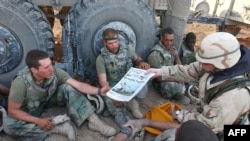Supporters of the U.S. military newspaper Stars and Stripes are using a public consultation period on the outlet’s regulations to try to roll back what they say are restrictive rules.
Funded in part by the Department of Defense but editorially independent by order of Congress, the Stripes has operated under the same Federal Register regulations since 1993.
But with updates to those rules open to public comment until Monday, journalists and media analysts are drawing attention to three longstanding articles they believe should be relaxed or scrapped entirely.
These include vague wording that doesn’t explicitly authorize reporters to ask questions of Defense Department officials, as well as regulations that block the paper’s staff from filing Freedom of Information Act, FOIA, requests or from publishing classified information that was legally obtained.
With the opportunity for change, some staffers and experts are calling for the rules to be relaxed in favor of an environment that better supports press freedom. Doing so, they say, would benefit the American soldiers who rely on the Stripes for information they can’t get from other news outlets.
The paper’s ombudsman, Jacqueline Smith, told VOA that the current regulations hinder the newspaper and threaten its independence. Others have pointed to the unique audience the paper serves.
“Stars and Stripes is really the most powerful weapon our troops carry into battle. And the reason I believe that is because it is a terrific representation of the good old American value that you can speak truth to power,” Kathy Kiely, chair in free press studies at the University of Missouri, told VOA.
“But it’s a constant struggle to maintain that independence,” she said. “There have been people who have been trying to mess with this since the beginning of the paper.”
The Stripes has existed in some form since 1861, and it has been published continuously since World War II. With staff in 18 locations around the world, it offers in-depth coverage to the U.S. military community.
Brian Brooks, who was editor of the European edition of Stripes in the late 1990s, emphasized that Congress mandated that the paper be a First Amendment publication.
“So, any attempt to invoke rules that would restrict Stars and Stripes reporters, is, in my opinion, a direct affront to Congress,” Brooks told VOA.
Some media rights advocates see the regulations as interference in the paper’s editorial independence.
“The government should not use its unique leverage over Stars and Stripes to restrict the First Amendment rights of its journalists,” Seth Stern, advocacy director at the Freedom of the Press Foundation, told VOA.
A Defense Department, or DoD, spokesperson told VOA that while the paper is editorially independent, its staff are DoD employees and so must “adhere to applicable DoD policies and federal laws and regulations, such as those regarding legal and ethical standards of federal employees and unauthorized disclosure of classified information.”
For Smith, the most concerning regulation is that Stripes reporters aren’t explicitly authorized to ask questions of Defense Department officials.
“It gets to the very heart of reporting, and reporters’ ability to move around and ask questions unhindered,” said Smith, who is based in Connecticut.
As the ombudsman, Smith acts as both a reader representative and a watchdog to ensure the newspaper’s First Amendment rights are respected. She cited examples of Stripes reporters who have been barred from covering events on bases without a military escort — which she said isn’t required.
Stripes reporters are also not permitted to submit FOIA requests, under the claim that they are exempt because they are classified as federal employees.
Brooks, who is now a professor emeritus at the Missouri School of Journalism, described that regulation as tantamount to censorship.
Jennifer Svan, a reporter at the newspaper for about two decades, said that while government agencies on occasion have overlooked the FOIA prohibition, it more often makes reporting much harder.
“Then we’re just relying on what the military is telling us about a particular issue, rather than seeing the documents that really paint the true picture of something that happened,” Svan, who is based in Germany, said. “It’s definitely been a challenge the whole time that I’ve been with Stars and Stripes.”
The regulations imposed on the newspaper indicate a tension between whether the Defense Department wants to treat Stripes like the legitimate news organization it’s Congressionally ordered to be, according to Kiely.
That tension has been the subject of a prior court ruling with a U.S. district court in 2003 ruling in favor of the paper in a case involving reporter’s privilege. The judge in that case found that although the paper is under the Defense Department’s purview, its staff — and the audience they serve — “enjoy the full protection of the First Amendment.”
While analysts say such regulations threaten the newspaper’s independence, the community affected the most is the soldiers and their families who read the newspaper.
“The people this hurts are the members of Stars and Stripes’ audience, are the men and women who are working every day to protect us,” Kiely said.
The public comment period concludes on June 24. After that, the Office of the Assistant to the Secretary of Defense reviews the comments. The Stripes would have the opportunity to be involved in any proposed updates.

